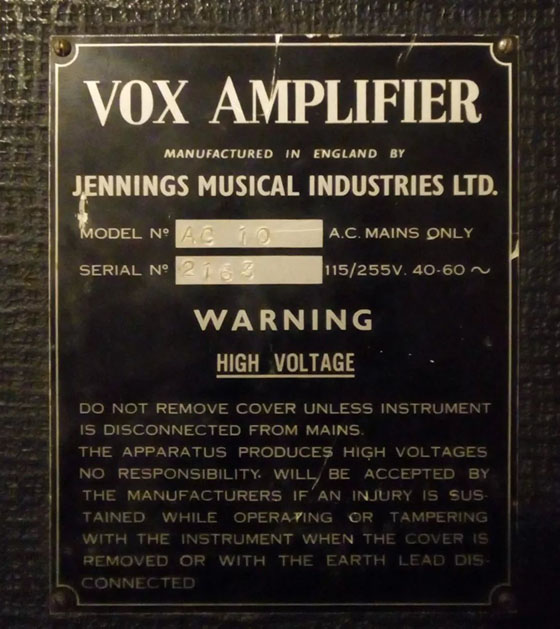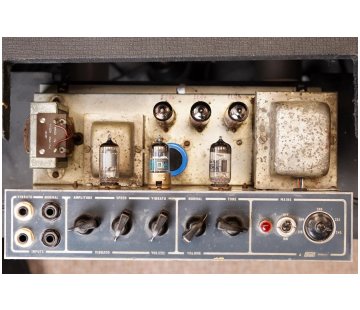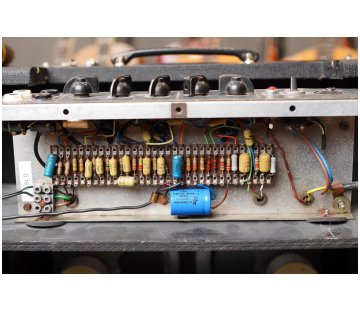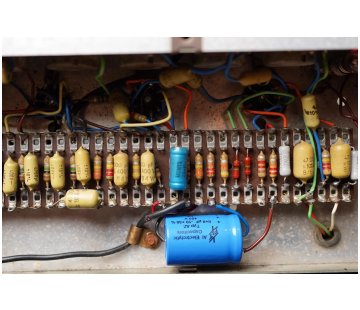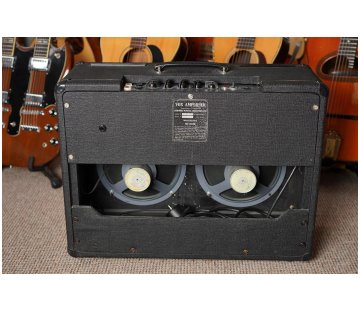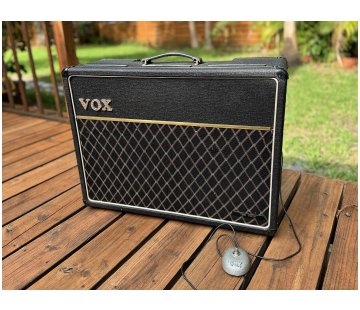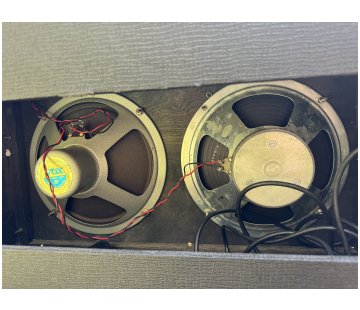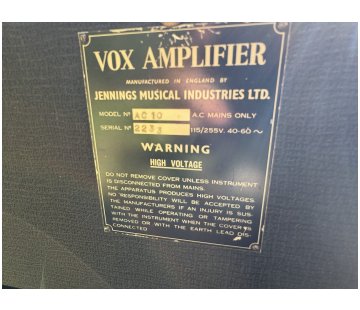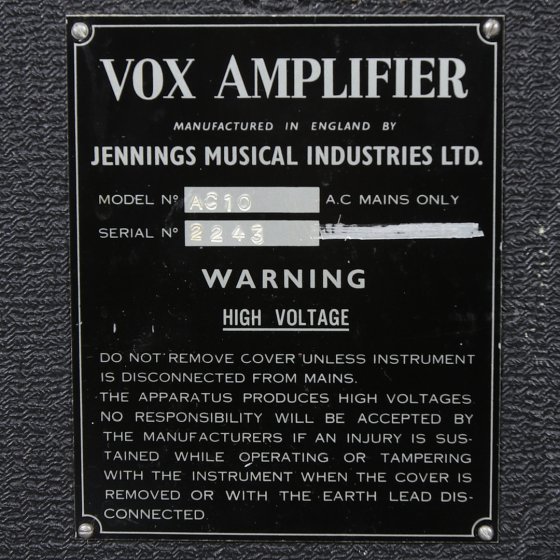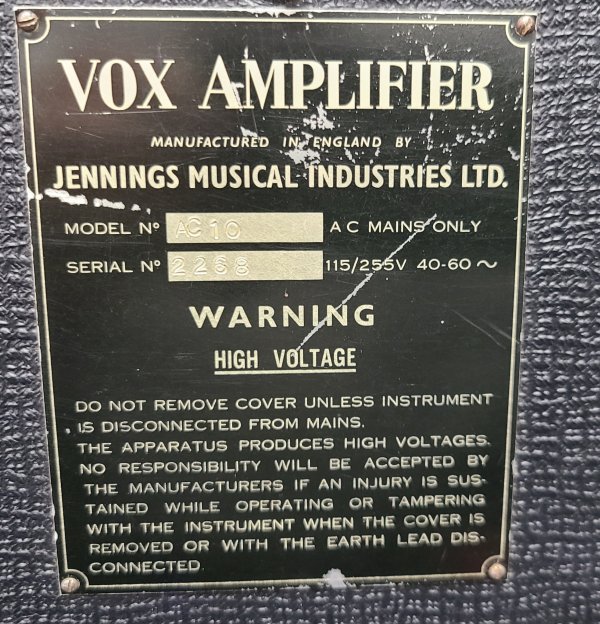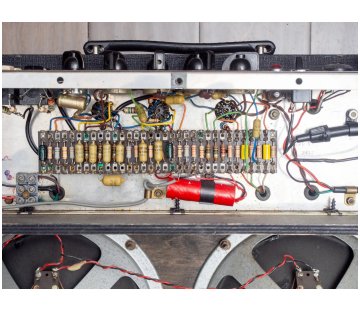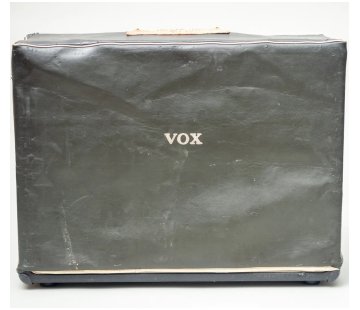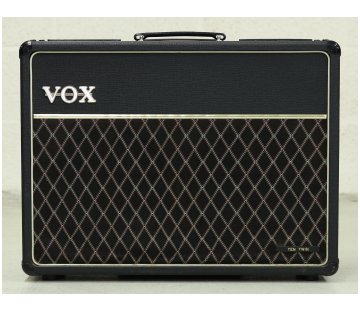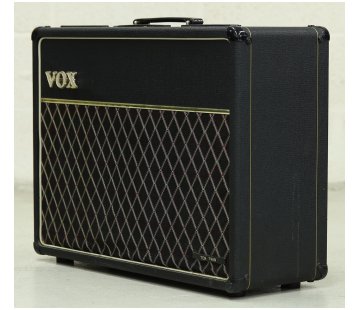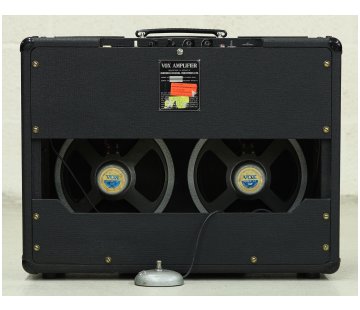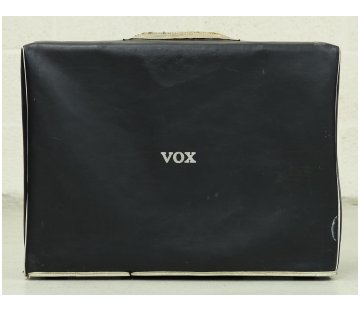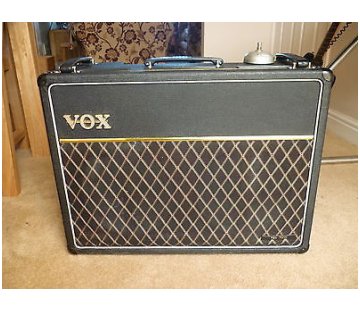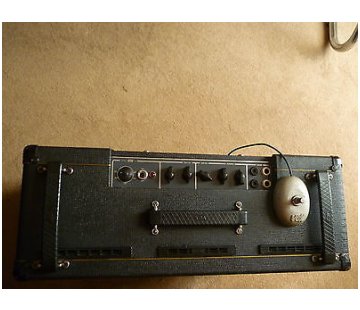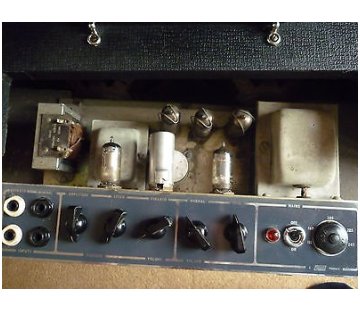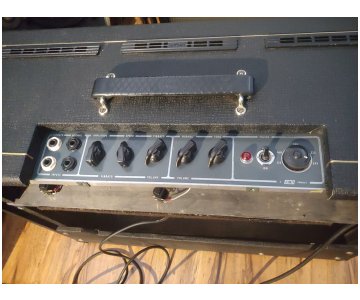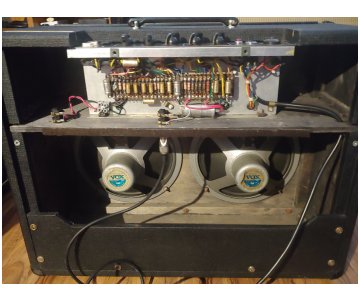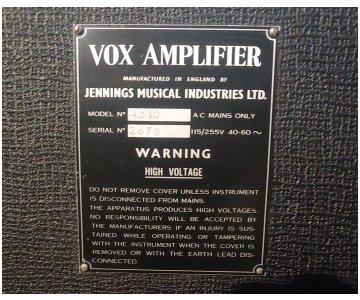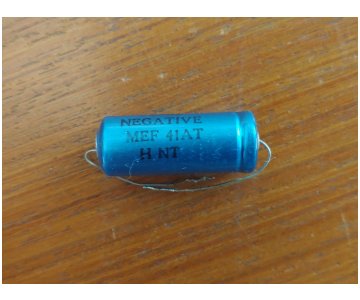The Vox AC10 Twin
Part 3, 1965 and later.
JMI official pricelist, November 1965.
This page picks up from the second page on AC10 Twins, 1964 to 1965, which can be found here. Notes on speakers, transformers, and various other components can be found there. Some of that material may be ported over in due course as this page grows - but not for the time being.
Thomas Organ - the USA
A detail replicating the first consolidated Thomas Vox pricelist "Effective April 26, 1965". The AC4, AC10 Twin, and AC10 Super Reverb Twins do not have names.
As mentioned on the page relating to AC10 Twins, 1964-1965, the "Million Dollar Deal" announced in late 1964 marked the beginning of a series of bulk exports of JMI amplifiers, guitars, and accessories to the Thomas Organ Company (headquartered in Chicago and Sepulveda). Some - at least - of the amps registered below will have been among the consignments. Thomas, to its great credit, soon got going with guides and literature not only for dealers and individual buyers, but technicians too. Principal among these were the "Pocket Reference Guides", which provided an overview of the key replacement parts that were available for the JMI amplifiers. The Guide also included handy photos of Bulgin connectors and so on - otherwise little known in the USA.
Thomas Organ "Pocket Reference Guide", early 1966. Presented here simply to give a sense of general appearance. The AC10 of course had a hard-wired mains lead.
Then, in September 1967, came the first edition of the "Vox Amplifiers Service Manual" - a digest of relevant material that had been gathered up to that point - some of it received from JMI (a certain number of Jennings diagrams survive only in the Manual), other items codified anew. For the AC10, this first edition contained a full list of spare parts (with order numbers) and the diagram reproduced below. In many ways this is the best and clearest expression of the amp's circuit.
First edition, "Vox Amplifiers Service Manual", September 1967.
Later editions of the Manual included a Tube Layout Diagram. Only the AC4 had been provided with such a diagram in the first edition.
That the AC10 had been deleted by Thomas from its pricelists and catalogues in late 1965 (in favour of its solid state Pacemaker) mattered little. Amps stocked by dealers naturally continued to sell - through to 1966. And the more that time went on, the greater the requirement for servicing.
Thomas Organ Service Bulletin no. 43, dated February 2, 1968, advised dealers that warranty on JMI amplifiers had expired - "The warranty on these products was for 12 months from date of sale or 18 months from date of manufacture, whichever came first". How exactly was date of manufacture known?. Presumably via the inspection tag attached to the amplifier chassis. Thomas doubtless recorded details of these in its ledgers. A selection of Thomas documents (including Bulletin no. 45) will be made available on a separate page.
Exports to Europe and the Commonwealth
In Europe, sales of the AC10 do not appear to have been strong - certainly not as strong as in the UK. This was probably a consequence of advertising (or not). For the most part JMI chose to concentrate on the AC30, AC50, and AC100, amps used by The Beatles and others. Just to note that the AC10 Normal (single speaker), listed in the Nicholson's (Sydney) pricelist of spring 1966 printed by Jim Elyea, is likely to be an earlier amp (or batch) that was slow to sell.
Detail of a pricelist, April 1966.
Dates
Component date codes are simply that: a statement of the date on which the component or components in view were made; they do not give the date of the completion of the amp - only the "date after which" (terminus post quem). Bear in mind that components could sit on shelves for some time before being taken up for the assembly of an amp. By the same token too, finished chassis could sit for some time before being made up into saleable AC10s. There are three types of date to bear in mind therefore: (1) assembly of chassis, (2) the point at which the amp was ready for sale (with cabinet, speakers, and serial number), and (3) the point of sale. This last is rarely known, but there are instances. Surviving warranty documents show that AC30 Super Twin serial number 4831 was sold in January 1966.
Another thing to bear in mind is the fire at the Vox Works in early December 1965. This destroyed around 40,000 items. Reg Clarke, JMI's General Sales Manager, only specifically mentioned AC100s waiting to be shipped to America, but it is likely that numbers of other JMI amplifiers - AC10s included - were lost too. Production moved during the clean-up operation to another building, but it is clear that orders, assembly, and despatch were badly affected for at least two months.
It will be noticed that no stabs of any sort at the potential dates of surviving AC10s are given. This is for two inter-related reasons. First, the latest component date code found so far in an AC10 Twin is of early 1965. Yet Twins continued to be sold through to 1967.
An overview of surviving AC10 Twins (1965 and later)
This encompasses serial numbers in the range 2000 to around 3200. The name of contractor responsible for making the chassis is noted where known, along with component date codes, types of speaker, and so on. The solder joints of chassis assembled by Westrex for JMI are generally marked with red checker's dye. Chassis assembled by Burndept Electronics were stamped by Burndept with numbers. The highest number encountered so far is 2426 - reported for serial number 2787, which naturally means assembly of at least 1425, the upper limit probably being no more than 1500. The highest number definitively attested in a photograph (at present) is 2200. Burndept and Westrex - it should be said - generally used different types of capacitor: Westrex for instance gold-coloured WIMA signal capacitors, and Burndept Mullard "mustards".
Serial number 2013
Chassis assembled by Burndept. Parmeko transformers. In the preamp, Mullard mustard capacitors with date codes "C4N" and "D4N", third and last quarter of 1964. One of the blue Hunts bypass caps has "HIT" = 23rd week of 1964.
NEW
Serial number 2056
In good order externally, "VOX" composed of single letters. The speakers are silver Elac 10N/85 with old-style "tin-can" magnets.
Serial number 2074
Chassis assembled by Burndept; number 1918(?). Parmeko transformers. In the preamp, Mullard caps with "B4N" and "D4N" date codes = second and last quarters of 1964. The orientation of the speaker labels in relation to the solder terminals suggests that these Elacs come from a Line Source 40 column.
Serial number in the low 2000s
Assembled by Burndept. Chassis number 2197 (not 2137 as previously stated). Parmeko transformers. All electronics original so far as can be seen. In the preamp, Mullard mustard capacitors with date codes "B/64", "B4N", and "D4N" = second and last quarters of 1964 for their manufacture. One of the blue Hunts filter caps has "HST" = 25th week of 1964. Original Elac speakers and footswitch are still present. Thanks to Henk for the pictures.
Serial number 2101
Chassis number 2336; Parmeko transformers. In the preamp, Mullard mustards with "B/64", "C4N", and "D4N" = second, third, and last quarters of 1964 for their manufacture. One of the original Hunts capacitors, now replaced, has "TTT" = 44th week of 1964.
Serial number 2113
Now known to survive. Thanks to Jon for the info.
NEW
Serial number 2118
Good condition externally, "VOX" composed of single letters. The silver Elacs have end bells.
Serial number 2163
In the preamp, visible Mullard mustard capacitors have the date code "D4N" = last quarter of 1964. One of the Hunts electrolytics has "HUT" = 26th week of '64.
Serial number 2180
Parmeko transformers. The Hunts capacitor underchassis has the date code "TTT" = 44th week of 1964 for its manufacture. The orginal silver Elac speakers are present.
Serial number 2182
Original speakers still in place.
Serial number 2194
Chassis assembled by Westrex. Parmeko transformers. The speakers are now a pair of Celestion 7442s (replacements for the originals). Pictures to follow shortly.
Serial number 2211
Parmeko transformers. In the preamp, visible Mullard mustards dated second and third quarters of 1964. One of the Hunts caps has "HWT" = 20th week of 1964 for its manufacture. Speakers are now dark grey Elacs from a Watkins amplifier.
Serial number 2214
Serial number 2230
Chassis number 01563. Mullard mustards with "C3W", "B4N", and "B/64" = third quarter of 1963 and second quarter of '64. Blue Elac speakers (of the old type) are now in the speaker compartment. A Top Boost unit was added at some point to the back panel.
Serial number 2233
Chassis number stamped on the chassis plinth: 01332; Parmeko transformers. Visible Mullard mustards have "B4W" and "B/64" date codes = second quarter of 1964. One of the original Elac speakers has been renewed.
Serial number 2243
Exported early on to Scandinavia.
NEW
Serial number 2268
Parmeko transformers. The chassis looks to be in good electronic order. In the preamp, Mullard mustard capacitors with "B/64", "C/64", and "D4N", respectively second, third, and fourth quarters of 1964 for their manufacture. The Mullard yellow-print EF86 has a 1964 paint code (month unknown). Silver Elacs with end bells.
Serial number 2276
Parmeko transformers; original silver Elacs in place.
Serial number 2289
Chassis number 2417; Parmeko transformers. In the preamp, Mullard mustards with "B4N", "C4N", and "D4N" = second, third, and last quarters of 1964 for their manufacture. The original silver Elacs are present. The original dark green cover with VOX logo survives.
Serial number 2345
Chassis assembled by Burndept, number 2447. Parmeko transformers. In the preamp, the Mullard mustards have "B4N" and "D4N" date codes = second and last quarters of 1964. The blue Hunts cathode bypass caps have "HUT" = 26th week of '64. The original cover survives. The silver Elacs were evidently given new wiring at some point. The footswitch is from a later 1970s Vox AC30. Thanks to John for the pictures.
Serial number 2352
Chassis assembled by Burndept; number 2314. Parmeko transformers. In the preamp, blue Hunts caps with date codes "HUT" and "TTT" = 26th and 44th weeks of 1964 respectively for their manufacture, and Mullard mustards with date codes "B/64", "C/64", and "D4N" - second, third, and last quarters of 1964. The original silver Elacs are still in place. Along with the warranty card, maintenance book, the original cover also survives.
Serial number 2397
Chassis assembled by Burndept; number 2028. Parmeko transformers. At least one of the electrolytic caps has a September 1964 date code. Original Elac speakers in place.
Updated
Serial number 2419
Copper panel - probably a repro. The original dome voltage selector is in place. No details of the electronics. The speakers are now Celestion 7721s with VOX labels, date code "WEL": "W" = 1965.
Serial number 2426
Serial number 2502
Old pics (and small). Replaced speakers but otherwise in good external order.
Serial number 2505
Chassis assembled by Burndept; number 2012. Parmeko transformers. In the preamp, Mullard mustards with "B/64", "C/64" and "D4N" date codes = respectively second, third, and last quarters of 1964. The main Hunts preamp filter cap has "TIT" = 41st week of 1964. The Elac speakers are wired in parallel - original wiring - not series as originally stated.
Serial number 2549
Serial number 2582
Serial number 2583
Chassis assembled by Westrex; a mixture of Albion and Parmeko transformers. The original yellow-print Mullard valves survive. Only the months of two are known at present: January (1965?) and June. In the preamp, one of the pots has the date code "IL" = September 1964 for its manufacture. The original cover survives. The initials "KS" chalked inside the speaker compartment.
Serial number 2604
NEW
Serial number 2678
In good general condition all round, speaker and footswitch jacks added to the slider board. Chassis assembled by Westrex, red-print WIMA signal caps in the preamp. The blue Hunts cap pictured has the date code "HNT" = 27th week of 1964 for its manufacture. Thanks to Glen for the pictures.
Serial number 2688
Chassis number 2496; Parmeko transformers. In the preamp, Mullard mustard caps with "B4N", "C4N", and "D4N" date codes = second, third, and last quarters of 1964. One of the Hunts caps has "HIT" = 23rd week of 1964 for its manufacture. The original Elacs are in place.
Serial number 2746
Chassis number 2291; Parmeko transformers. In the preamp, Mullard mustard caps with "B4N", "C4N", and "D4N" date codes = second, third, and last quarters of 1964. As above, the original Elacs are in place.
Serial number 2787
Chassis assembled by Burndept. The reported chassis number is 2426. The original Elacs were said to be in place.
Serial number 2817
Serial number 2837
Small pictures from some time ago.
From this point, serial number plates machine stamped
The machine stamping is likely to have begun at 3000. "/T" was added to designate "Twin". For AC100s, the machine stamping of numbers began at 300 (just to provide a parallel for reference).
Serial number 3053
Detail of the plate.
Serial number 3153
Chassis produced by Westrex; Albion transformers. In the preamp, WIMA capacitors; gold TCC capacitors with the date code "VF" = June 1964. "164" is written on the right-hand side of the aluminium upright. The valves are yellow-print Mullard, with paint codes: "KK" and "LE" = October 1963, and May 1964. The silver Elac speakers have been rewired at some point.
Serial number 3155
Reported by J. Elyea, p. 529.
Serial number 3163
Chassis number 2207(?). Fairly extensively overhauled - no original components with date codes visible. Original Parmeko transformers still in place. The main carrying handle has an empty panel (no "VOX"). Pictured with the amp, blue Elac 10N/81s from some other source.
For early AC10 Twins see this page.
The main AC10 index page can be found here.

























